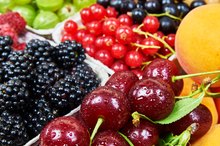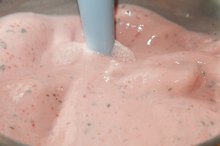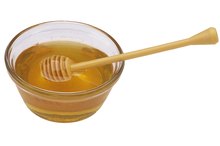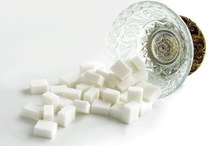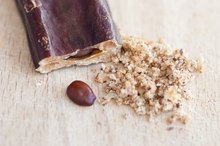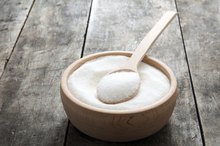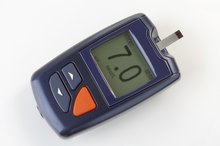What does fact checked mean?
At Healthfully, we strive to deliver objective content that is accurate and up-to-date. Our team periodically reviews articles in order to ensure content quality. The sources cited below consist of evidence from peer-reviewed journals, prominent medical organizations, academic associations, and government data.
The information contained on this site is for informational purposes only, and should not be used as a substitute for the advice of a professional health care provider. Please check with the appropriate physician regarding health questions and concerns. Although we strive to deliver accurate and up-to-date information, no guarantee to that effect is made.
Fructose Vs. Maltodextrin
Today's food supply has such a wide variety of ingredients that it is often difficult to identify added sugars on food labels. Typically, sugars can be identified on food labels by the ending “ose” such as fructose, glucose or lactose. However, maltodextrin is an exception to that rule.
Fructose
Fructose is a simple sugar because it is made up of one carbohydrate unit and can be absorbed as it is. According to Mosby's Medical Dictionary, fructose is found naturally in fruits, some vegetables and honey, and is at times listed as levulose on food labels 1. Fructose is often mistaken as the superior sugar because it can be found in fruits. However, it is not the fructose that provides the nutritional value, but rather the vitamins, minerals, phytochemicals and antioxidants naturally found in the fruit that provide the nutritional benefit.
- Fructose is a simple sugar because it is made up of one carbohydrate unit and can be absorbed as it is.
- According to Mosby's Medical Dictionary, fructose is found naturally in fruits, some vegetables and honey, and is at times listed as levulose on food labels 1.
Fructose as an Additive
Foods Containing Glucose or Fructose
Learn More
People can get into trouble with fructose when trying to satisfy sweet cravings, as many foods on the market use fructose as a sweetener. Fructose is slightly sweeter than table sugar, or sucrose, which is the main reason for its popularity. According to the Academy of Nutrition and Dietetics, large amounts of fructose as an additive can increase triglyceride levels, which are linked to an increased risk of heart disease. Excess consumption can also contribute to weight gain and obesity, as it is thought that fructose may affect appetite-regulating hormones.
- People can get into trouble with fructose when trying to satisfy sweet cravings, as many foods on the market use fructose as a sweetener.
- Excess consumption can also contribute to weight gain and obesity, as it is thought that fructose may affect appetite-regulating hormones.
Maltodextrin
Maltodextrin is not often recognized on food labels as a sugar because it doesn’t have the familiar “ose” ending. Maltodextrin is found in foods such as salad dressings, canned fruits, weight gainer supplements and a variety of snack foods; it is also a main ingredient in the brand-name sugar substitute Splenda. Maltodextrin is made from corn starch but it can also be made from potatoes or rice, and unlike fructose, it is less sweet than sugar. Maltodextrin does not provide any nutrients, only calories. But, unlike fructose, it also has an important role as a thickening agent to enhance the texture of certain foods.
- Maltodextrin is not often recognized on food labels as a sugar because it doesn’t have the familiar “ose” ending.
- Maltodextrin is made from corn starch but it can also be made from potatoes or rice, and unlike fructose, it is less sweet than sugar.
Maltodextrin and Fructose in Exercise
Substitutes for Fructose
Learn More
Maltodextrin and fructose play different roles when used for endurance sports. Many commercially sold sports drinks use maltodextrin to ensure sustained energy during endurance training. Maltodextrin is often the preferred sugar for both taste and color, and because it is metabolized slowly and easily digested. Sports nutrition products with maltodextrin are also used post-exercise to replenish carbohydrates depleted during exercise. Maltodextrin, unlike fructose, has a high glycemic index which ranges from 105 - 136 on glycemic index charts while fructose has a much lower glycemic index of around 23. Fructose is not the best choice of energy during exercise as it is not converted to energy very quickly and it is often the blame for bloating, cramping and diarrhea. This gastrointestinal distress may be attributed to its lower glycemic index and slower absorption rate.
- Maltodextrin and fructose play different roles when used for endurance sports.
- Maltodextrin is often the preferred sugar for both taste and color, and because it is metabolized slowly and easily digested.
Conclusion
The Center for Science in the Public Interest has recognized maltodextrin as safe and fructose as an additive to cut back on in the diet 2. Experts agree that sugar, no matter the form, should comprise no more than 10 percent of total caloric intake. Most Americans get double this recommendation.
- The Center for Science in the Public Interest has recognized maltodextrin as safe and fructose as an additive to cut back on in the diet 2.
- Experts agree that sugar, no matter the form, should comprise no more than 10 percent of total caloric intake.
Related Articles
References
- Mosby's Medical Dictionary: Fructose
- Center for Science in the Public Interest: Chemical Cuisine
- Popkin BM, Hawkes C. Sweetening of the global diet, particularly beverages: patterns, trends, and policy responses. Lancet Diabetes Endocrinol. 2015;4(2):174-186. doi:10.1016/S2213-8587(15)00419-2
- New Hampshire Department of Health and Human Services. How much sugar do you eat?. Updated August 2014.
- DeSilver D. How America's diet has changed over time. Pew Research Center. Updated December 13, 2016.
- Lakhan SE, Kirchgessner A. The emerging role of dietary fructose in obesity and cognitive decline. Nutr J. 2013;12:114. doi:10.1186/1475-2891-12-114
- Djiogue S, Nwabo Kamdje AH, Vecchio L, et al. Insulin resistance and cancer: the role of insulin and IGFs. Endocr Relat Cancer. 2013;20(1):R1-R17. doi:10.1530/ERC-12-0324
- Page KA, Chan O, Arora J, et al. Effects of fructose vs glucose on regional cerebral blood flow in brain regions involved with appetite and reward pathways. JAMA. 2013;309(1):63-70. doi:10.1001/jama.2012.116975
- Goran MI, Ulijaszek SJ, Ventura EE. High fructose corn syrup and diabetes prevalence: a global perspective. Glob Public Health. 2013;8(1):55-64. doi:10.1080/17441692.2012.736257
- Walker RW, Dumke KA, Goran MI. Fructose content in popular beverages made with and without high-fructose corn syrup. Nutrition. 2014;30(7-8):928-35. doi:10.1016/j.nut.2014.04.003
- American Heart Association. Added sugars. Updated April 17, 2018.
Writer Bio
Kay Klumpyan began writing in 2010 with work published in the “Journal of Nutrition Education and Behavior.” She is a registered dietitian and holds certifications in weight management and fitness instruction. She holds a Bachelor of Science in dietetics from the University of Wisconsin and she is studying for a Master’s in Public Health from the University of Las Vegas, Nevada.

